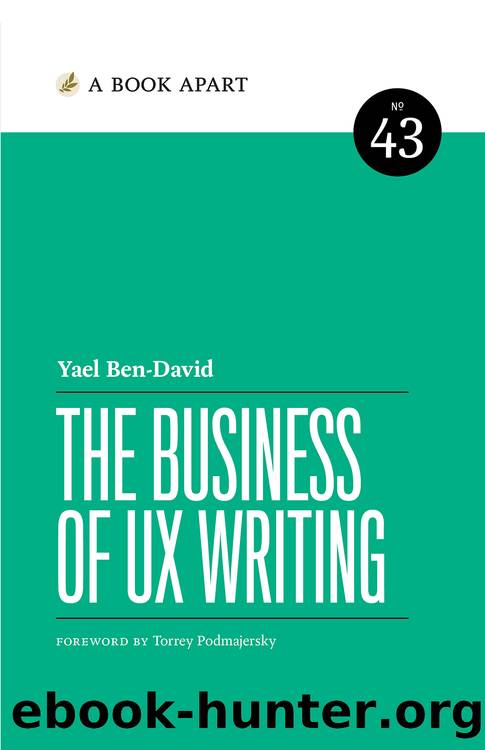The Business of UX Writing (for True Epub) by Yael Ben-David

Author:Yael Ben-David
Language: eng
Format: epub
ISBN: 9781952616259
Publisher: A Book Apart
Published: 2022-11-23T16:37:28+00:00
Accessibility
Tech is the future. Itâs unethical to limit innovations in tech to a select few. If tech evolves only for certain groups, privilege is exacerbated and the chasm between the haves and the have-nots deepens, depriving us all of synergy left untapped. Products are more useful, businesses more successful, and humanity better off when tech behaves ethicallyâand UXW has a big role to play in that.
Accessibility means making products usable for people who might otherwise face barriers to entry beyond their control. Originally, permanent physical barriers were at the core of the conversation, and screen readers used by people with visual impairments were the primary use case. âAccessibilityâ at that time was often a buzzword for alt text and similar UXW tools and techniques used for making visual UI accessible to people who consume content in ways that are not dependent on sight.
Over time, the accessibility conversation broadened to include not only additional permanent physical barriers like color vision deficiency, but also long-term, nonphysical barriers like neurodiversity, low literacy, and low digital literacy; temporary barriers like injury; and situational barriers like a new parent dealing with constant distractions and extreme fatigue, or a person trying to use a voice interface in a loud, public space.
Itâs easy to see how making products accessible to those with permanent, temporary, and situational barriers to entry is ethical, but it also makes good (business) sense. Without accommodating people who experience these barriers, a huge potential marketâan estimated 18 percent of the population in the UK lives with a disability (https://bkaprt.com/buxw43/03-07)âis off-limits to the business. Furthermore, accessibility is becoming a legal requirement in more countries, and risking lawsuits is not in the businessâs best interest (Web Content Accessibility Guidelines [WCAG] 2.1) (https://bkaprt.com/buxw43/03-08).
Writing alt text for images and meaningful link text (as opposed to âLearn moreâ and âClick hereâ) makes visual content accessible to users who, for any number of reasons, consume content using screen readers. Closed captioning on videos helps lower barriers to consuming audio content for those who are hard of hearing or located in a quiet library or on loud public transportation. Alt text, meaningful link text, and closed captioning all fall within the realm of UXW (https://bkaprt.com/buxw43/03-09).
We can write without reference to design elements like âtabsâ and âwindows,â or to tech jargon like ânavigate,â to make flows accessible to people with low digital literacy. We can use tools like Hemingway App (https://bkaprt.com/buxw43/03-10) to make sure we keep our copy at an accessible reading level for everyone, and we can apply evidence-based recommendations in the crowd-sourced Readability Guidelines (https://bkaprt.com/buxw43/03-11). These are all in the UX writerâs purview.
Products can also integrate out-of-the-box solutions, including accessiBe (Fig 3.14), which can help us catch the lowest-hanging fruit until weâre able to expand our in-house accessibility efforts.
Download
This site does not store any files on its server. We only index and link to content provided by other sites. Please contact the content providers to delete copyright contents if any and email us, we'll remove relevant links or contents immediately.
Asking the Right Questions: A Guide to Critical Thinking by M. Neil Browne & Stuart M. Keeley(5572)
Autoboyography by Christina Lauren(5154)
Eat That Frog! by Brian Tracy(4377)
Dialogue by Robert McKee(4271)
Sticky Fingers by Joe Hagan(4060)
Journeys Out of the Body by Robert Monroe(3535)
Annapurna by Maurice Herzog(3395)
Full Circle by Michael Palin(3346)
Schaum's Quick Guide to Writing Great Short Stories by Margaret Lucke(3278)
Elements of Style 2017 by Richard De A'Morelli(3278)
The Art of Dramatic Writing: Its Basis in the Creative Interpretation of Human Motives by Egri Lajos(2944)
Why I Write by George Orwell(2849)
The Diviners by Libba Bray(2840)
In Patagonia by Bruce Chatwin(2829)
The Mental Game of Writing: How to Overcome Obstacles, Stay Creative and Productive, and Free Your Mind for Success by James Scott Bell(2816)
The Fight by Norman Mailer(2793)
Atlas Obscura by Joshua Foer(2757)
Venice by Jan Morris(2494)
The Elements of Style by William Strunk and E. B. White(2413)
